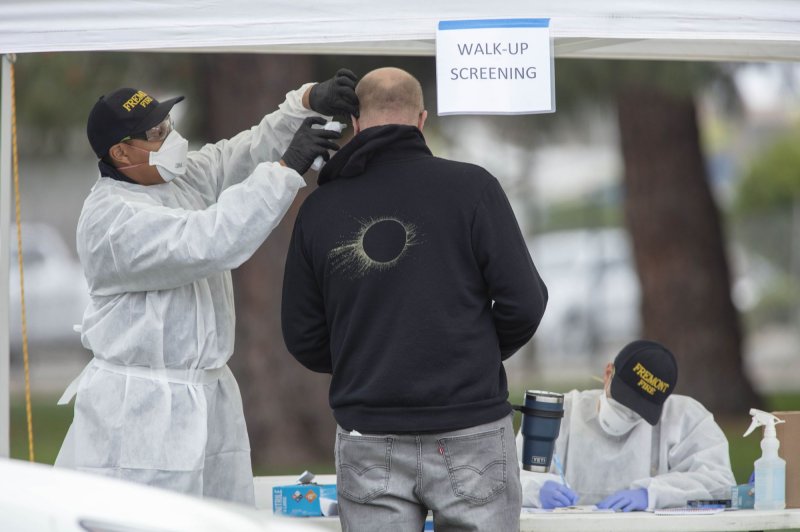1 of 2 | Doctors, nurses, medical technicians and healthcare specialists are manning the front lines in this fight. Photo by Peter DaSilva/UPI |
License Photo
"War" has been declared against the coronavirus. But waging war against any inanimate entity is inherently risky. Consider how wars against poverty, crime, drugs and terror fared. Still, rallying the nation is essential if this viral killer is to be defeated.
Recalling a certain parallel with the immediate aftermath of Japan's attack on Pearl Harbor on Dec. 7, 1941 is instructive. It is Dec. 8 in Washington. After President Franklin D. Roosevelt's stirring speech to Congress and the subsequent declaration of war, how were the public and government grappling with the attack that put the U.S. Navy's battleship fleet at the bottom of Pearl Harbor?
Roosevelt had been moving the nation toward war for some time, signing Lend Lease to aid Great Britain; renewing the draft by a single vote; and signing the various Vinson-Trammel naval construction bills that built 6,000 warships before World War II ended. However, FDR's target was Adolf Hitler and Europe and not the Pacific. The task was immense: organizing the nation to fight a global war.
The sense of desperation and vulnerability was overcome by anger and fury over Japan's "sneak attack" that Roosevelt so elegantly described as "dastardly." Were politicians today so articulate. Japan's Adm. Isokuro Yamamoto, who planned the attack, understood that "a sleeping giant" would be awakened. In 45 months, that giant had forced Japan (and with Allies that May, Germany) to accept unconditional surrender.
Seventy-five years later, COVID-19 is a new form of attack, catching certainly Western states by near complete surprise, or at least the leadership. And, as with Pearl Harbor, a few warnings were issued that would not be taken seriously. One significant difference is that Pearl Harbor was a sudden and instantaneous shock. It took weeks for coronavirus to achieve at least that level of impact.
A similarity with the war that followed and today is the courage that was and will be shown. The difference is the participants. Valor occurred almost entirely on, under or above the battlefields. Soldiers, marines, sailors and airmen heroically risked and lost lives in combat in defense of the nation.
Today's heroes in the battle against coronavirus wear different and even no uniforms. Doctors, nurses, medical technicians and healthcare specialists are manning the front lines. Except with a virus, no front lines really exist beyond the need to deal directly with the sick. And many unsung heroes with seemingly mundane but as it turns out vitally important jobs are in the fight.
Staffs in supermarkets, pharmacies, banks, transportation, utilities and emergency services to include police and firefighters, along with others too numerous to count, will be risking their lives to carry out the basic yet vital necessities of every day life. Wielding masks, gloves and copious amounts of soap rather than rifles, bayonets, artillery and other weapons of war, these Americans are the equivalent of the infantry, fighter and bomber pilots, warship crews and other combat arms personnel on which victory, success or failure rest.
What can be done to support these brave and often invisible Americans? First, as with the military, a system of awards for valor and superior service must be established on a national basis. As awards can be issued at different levels of seniority in the military, governors, mayors, city managers and other people in authority must have the ability to present or recommend presentations of medals. And if that means awarding medals for hundreds of thousands or more who display courage and valor over time, these awards are well deserved.
Next, hearken back to December 1941 and the planning that followed. The first White House visitor was British Prime Minister Winston Churchill, who risked the long journey to meet with FDR and decide on the overall strategy. Churchill stayed over a month. There needs to be a convocation of world leaders, obviously electronically, to establish strategy. And this cannot be limited to a few hours.
As a comprehensive plan for victory was fashioned in and near the White House and adjacent State, War and Navy Building, a similar initiative is essential. The plan must begin with setting achievable aims and be as comprehensive as possible. As plans do not usually survive the first contact with the enemy, this plan must be flexible and revised on a continuing basis.
While focus will be at home, the international dimension is vital. What is happening elsewhere is vital to what is happening here. That too must be assimilated and incorporated.
Whether the war analogy is appropriate or not, this is a titanic struggle. And it is one we cannot lose.
Harlan Ullman is a senior adviser at the Atlantic Council. His latest book is "Anatomy of Failure: Why America Has Lost Every War It Starts." Follow him @harlankullman.















